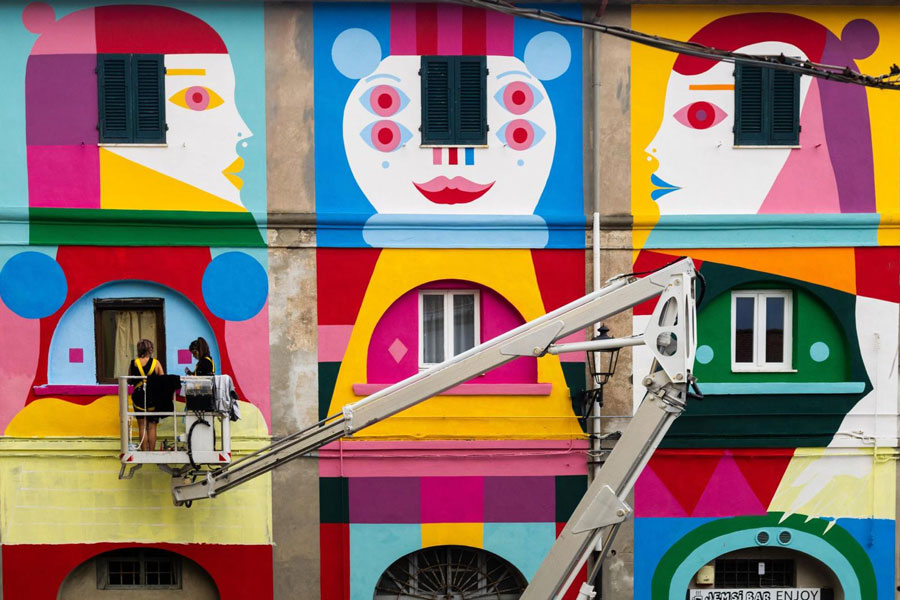Caiarossa will host two site-specific installations curated by the artists Samuel Rosi, aka Muz with a live painting in the cellar and the story on paper by Enrico Bani with the grape marc.
As part of the Festival “la Collina delle Fiabe”, promoted by the Municipality of Riparbella in collaboration with Start Attitude and the curator Gian Guido Grassi, on Saturday 5 October, the Caiarossa, Cava, Prima Pietra and Quercia Luce wineries will unite, transforming themselves into a true artistic network, welcoming contemporary artists and site-specific installations. Caiarossa opens its doors to the mural work of Muz and that on paper by Enrico Bani .
“The Riparbella Wine Trail” will take visitors on a journey through the evocative panoramas of this village on the Tuscan coast to discover some of the most important wineries in this area, including Caiarossa, with a special tour departing at 10 am and 3 pm (the meeting point will be at the Riparbella tourist office in Piazza del Popolo).
Enrico Bani’s work develops by integrating his vision with the use of grape marc, a waste product in wine production, a biodegradable mass. The artist describes his work as follows: “the grape marc is variable over time, here it takes on a new body and becomes a sign and chromatic element on paper. The work is based on a study that aims to place writing at its center, more precisely its elementary particle, the letter, which, freed from its communicative role, abstracts into a graphic and material sign in space through a regression and deconstruction of the typographic element until it is transported into a primordial sign vision .”
The structure of the installation also connects to the surrounding space of the cellar thanks to the use of small metal elements “that bring the viewer back to that industrial vision, difficult to find immersed in this local Tuscan reality of wine production, made of vineyards, hills and panoramas immersed in nature”.
The live painting by Samuel Rosi, aka Muz, instead, takes inspiration from an Etruscan bucchero, a carafe commonly used for wine. “ The idea was – explains the artist – to connect the territory, known as the Etruscan Coast, with the role of the place through the drawing. The execution uses a product capable of creating a relief, after applying a stencil, on the wall. Once the drawing is obtained, the same background color is reused. The work will be visible thanks to the play of light/dark contrast created by the light on the wall ”.
The exhibition continues in the cellar admiring other works by the two artists. Enrico Bani, born in 1996, graduated from the School of Graphics of the Academy of Fine Arts in Carrara. During his studies he dedicated himself to research in the field of contemporary art graphics integrating tradition with contemporaneity, he studied new chalcographic techniques. The artist places the letter at the center of his research which, emancipated from its communicative role, abstracts into a graphic and material sign in space. Samuel Rosi, aka Muz, born in 1995 in San Miniato. He graduated in Painting from the Academy of Fine Arts of Brera. He lives and works in Cerreto Guidi. Coming from the context of urban art, he has developed an attraction towards the contemporary landscape, a place without horizons and capable of lending itself to any type of constitutive element. The urban landscape thus becomes a way to rethink space as a set of relationships, a support on which to intervene. Within a contemporary design, the landscape acquires relevance: it becomes a new paradigm of contemporary design.
CAIAROSSA
It was 2004 when Eric Albada Jelgersma decided to purchase an estate in this special part of Italy, bringing with him the knowledge developed over the years in Bordeaux, with Château Giscours, a well-known winery in the Margaux appellation of the Bordeaux region of France.
Eric Albada fell in love with this small but beautiful winery, immersed in the Mediterranean scrub, on the western side of a hill overlooking the sea. Today, his children Dennis, Derk and Valérie continue in their father’s footsteps and continue to work in search of maximum precision in the production of wines.
This research is aimed at maximum connection with the rhythm of nature, and this is why since its birth the winery has followed the principles of biodynamic agriculture, with the aim of increasing the vitality and resilience of the soil. Caiarossa wines are unique: refined blends outline a research between experimentation and balance. A harmony that returns the virtuous interpretation of the territory with French eyes.

